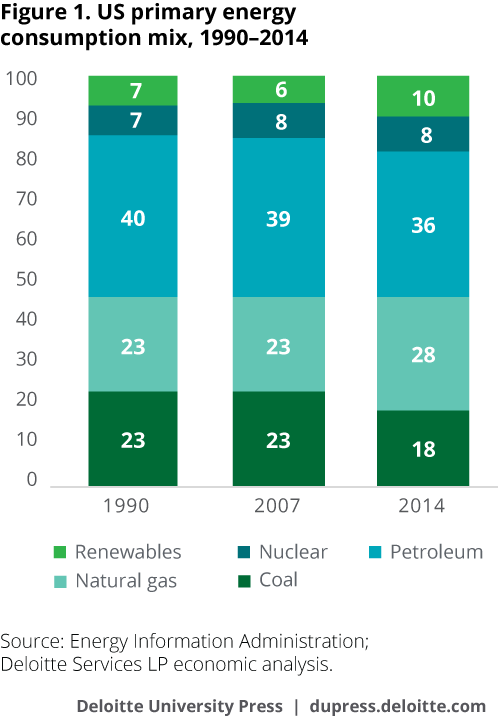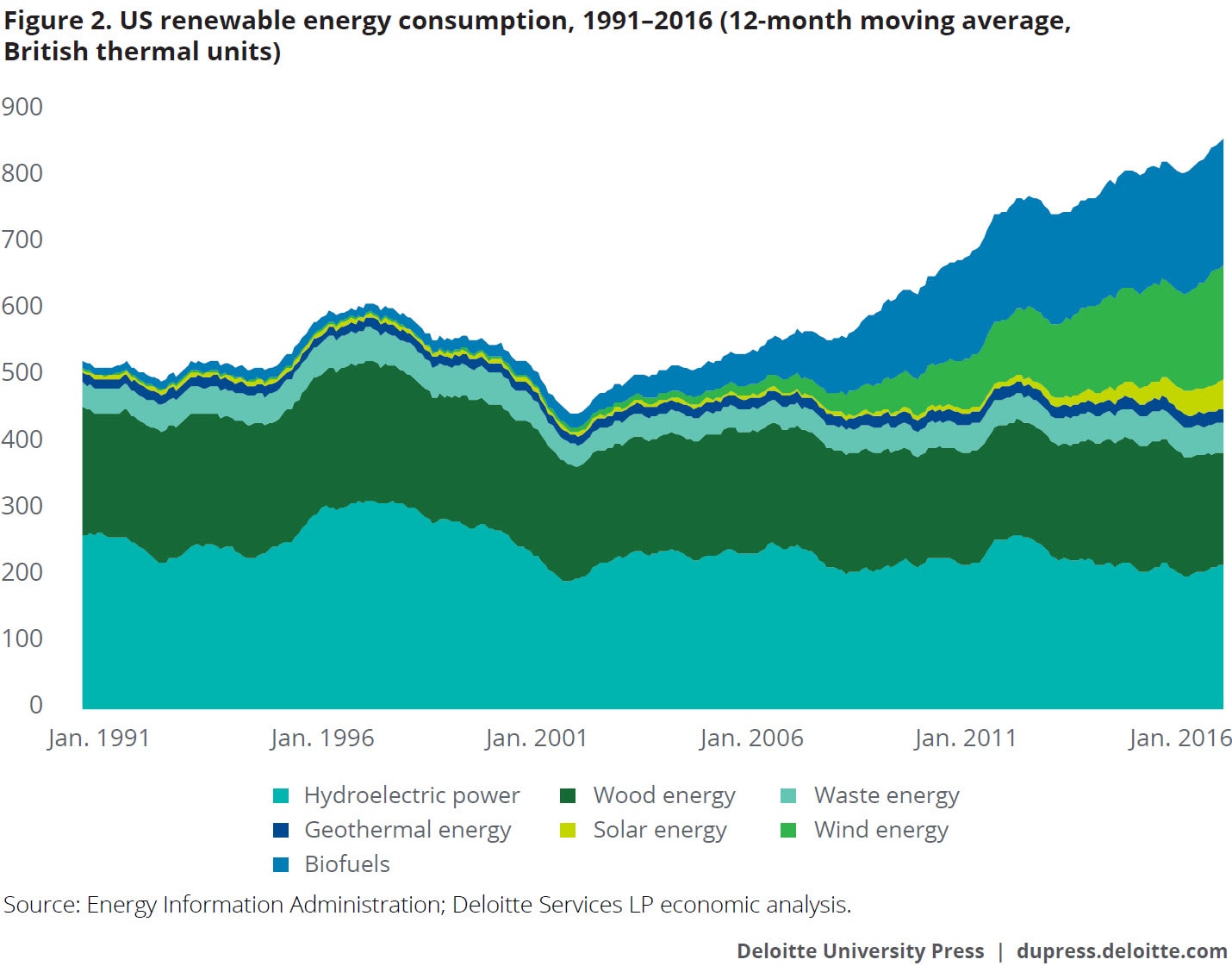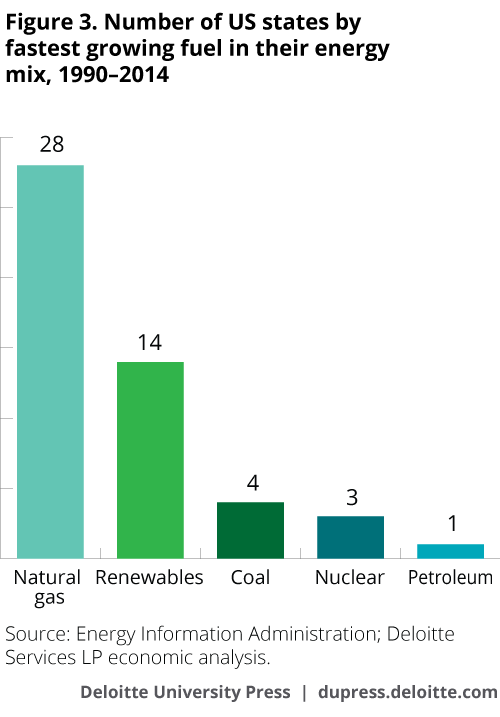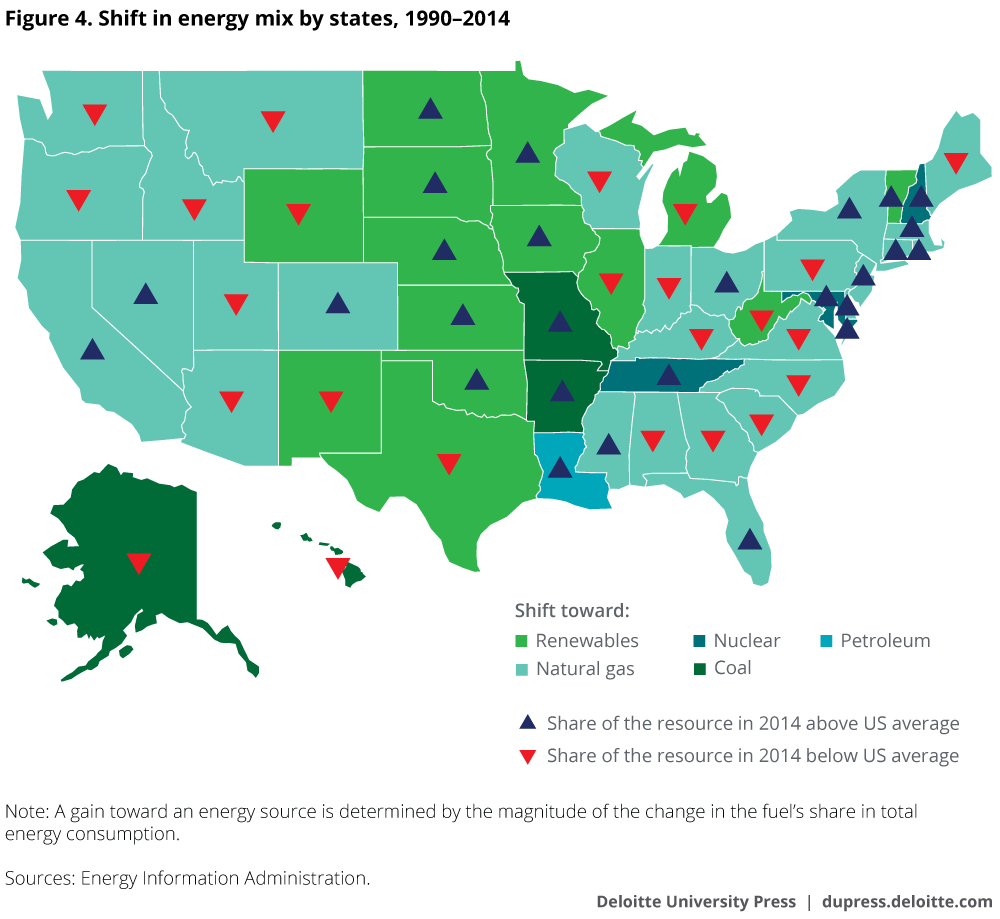Greening the mix: A look at changing energy consumption patterns and emission reduction has been saved

Greening the mix: A look at changing energy consumption patterns and emission reduction Behind the Numbers, November 2016
18 November 2016
A recent fall in US energy-related emission levels has been attributed to changing fuel consumption patterns, primarily toward natural gas. However, while natural gas is “cleaner” than other fossil fuels, it is far less clean than alternates such as renewables. Given how the country still heavily relies on fossil fuels for its energy needs, is the United States really on a path of reduced emissions?
Introduction
Explore
View the Behind the Numbers collection, a monthly series from Deloitte’s economists.
Recently, the United States made headlines for reporting the lowest carbon-dioxide emissions (2,530 million metric tons) during the first six months of 2016.1 This is the first time since 1991 that emissions have dropped to such low levels in the country. While a mild winter this year, with lower-than-normal heating degree-days, contributed to the decline, the changing fuel consumption mix over the years has also been an important factor, according to the Energy Information Administration.2

However, a deeper dive shows that the share of three carbon-emitting fossil fuels—coal, petroleum, and natural gas—in the overall energy consumption mix of the United States has continued to remain above 80 percent during the period from 1991 to 2014.3 Coal and petroleum together continue to be the largest consumed energy sources, although the economy is increasingly substituting coal for natural gas, which is a relatively cleaner source. In contrast, the combined share of cleaner, alternative energy sources (renewables and nuclear) in total energy consumption remained flat until 2007 before it rose by 4 percentage points in the following six years (figure 1) to 18 percent.4
If fossil fuels have continued to dominate US energy consumption and the reduction in emissions is largely driven by the movement toward natural gas rather than a significant shift toward cleaner and alternative sources energy, how sustainable is the emissions reduction in the long run?
For now, energy switches are concentrated in the electric power sector
For a long time, concerns about dependence on imported energy resources and higher emissions of carbon dioxide have led the United States to look for low-carbon, alternative energy sources. Rising income and technology advances, together with political will, have also enabled the economy to develop solutions that can shift energy consumption patterns toward lower carbon sources.
That said, the feasibility of changing the energy consumption mix toward alternative sources has remained limited due to several factors, such as geographic location, public policies, state of the infrastructure, public awareness, household composition, domestic availability, and the pace of urbanization. Habitual factors, such as ease of use and willingness to pay, and the growing demand for energy, have also played an important role.5 In addition, the use of petroleum is highly concentrated in the transportation sector where alternative energy-based transport options are limited, as yet.

Since 1990, the only sector that has witnessed a significant change in its energy usage pattern is the electric power sector as low-cost domestic natural gas displaced some coal generation (figure 1) and because of the availability of a direct set of policy instruments to regulators to influence the consumption mix. For example, starting in early 2000, several states began implementing Renewable Portfolio Standards (RPS), which are policies designed to increase electricity generation from renewable resources.6 The United States started witnessing a sturdy growth in renewables usage by 2007 as the impact of the RPS began to be felt, primarily driven by the use of wind and biofuels energy (figure 2).
The success story of a few states

While a majority of the states are implementing RPS, only a handful of them have noted some success in changing their overall energy consumption mix toward cleaner alternative energy sources. A comparison of the overall energy consumption pattern across each of the 50 US states during 1990–2014 reveals that most of the states mirrored national consumption trends (figure 3). Twenty-nine states preferred to move toward natural gas, which saw the maximum increase in its share relative to other fuels’ shares in those respective states. On the other hand, only 17 US states registered a larger increase in cleaner alternative energy usage versus other fuels in their energy mix. (Even among these states, the quantum of change for some was not significant or the current share of cleaner fuels remained far below the US average.)
Of these 17 states, 8 stood out in their effort to increase the proportion of renewables in the total energy consumption: South Dakota, Iowa, Vermont, Nebraska, Minnesota, North Dakota, Kansas, and Oklahoma. These states were increasingly substituting fossil fuels with renewables in a proportion higher than the US average because of the availability of natural resources and supportive policies in these states. Additionally, three states—Tennessee, Maryland, and New Hampshire—registered a significant gain in the share of nuclear (figure 4).

Surprisingly, four states—Alaska, Arkansas, Missouri, and Hawaii—saw coal’s share gaining the most in their energy mix. These states often face an uncertain supply of alternative fuels, while the lack of infrastructure and geographic location also make it difficult to increase consumption of low-carbon fuels. Evidently, three of these four states—Alaska, Hawaii, and Missouri—also had relatively low economic growth during this period.
Moving to renewable energy is achievable, affordable, and transformative
Former vice president and Nobel Peace Prize winner Al Gore once said that the “goal of producing all of the nation’s electricity from renewable energy and truly clean, carbon-free sources …. is achievable, affordable, and transformative."7 It definitely is, but needs to be tackled on a much wider scale. Until now, efforts to reduce emissions through greater adoption of cleaner fuels have been sporadic and limited to certain states or regions. While any change in this direction is welcome, a more uniform, nation-wide commitment toward alternate energy sources is necessary to create a tangible impact.
With recent technological advances and new distributed energy solutions, the goal of emission reduction seems more attainable. Additionally, supportive market forces, government policies, and the changing future of mobility (proliferation of shared and autonomous vehicles) over the next 10–15 years will most likely help the United States accelerate its move toward cleaner alternative energy sources, and ultimately, sustainable emission reduction. 8
© 2021. See Terms of Use for more information.




